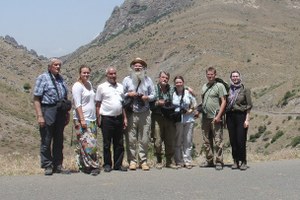Popular Science: Impressions from an Expedition to Azerbajjan
 Participants of the expedition. Source: Iveta Štolhoferová
Participants of the expedition. Source: Iveta Štolhoferová
At first we went south to Lenkoran and Lerik region. This area is located in Talysh Mountains and boarders with Caspian Sea. Thanks to these factors the region is one of the wettest in Azerbaijan. Also lower temperatures are usual there due to higher elevation (mostly between 1,000 and 1,200 AMSL). In the center of our interest were fish. In minibus step by step we searched for little mountain streams and learned to recognize their fauna. The most exciting “catch” was chub, less often seen by expeditions of previous years. We also caught frogs, mostly represented by genus Pelophylax (in this genus is e.g. the common grass frog).
Collected samples were used for DNA separation, analysis and as a basis for a phylogenetic tree (a tree showing the degree of relation between populations). These trees can be used in broader research for example as a basis for biogeographical maps. Blood was tested for presence of parasites, and measurements of morphological characteristics were completed.
We spent quite an amount of time with cameras in our hands. In two weeks, we took unbelievable 12,000 pictures. These pictures are an important source of information about the environment and communities of animals that may share an ecological relationship (competitors, predator, prey…).
 Agama p. caucasia; by Iveta Štolhoferová
Agama p. caucasia; by Iveta Štolhoferová
We spent almost a week in the Nakhichevan Autonomous Republic. Nakhichevan is separated from the core of Azerbaijan by Armenia, so to visit it, you have to take a plane. Our host in there was Nakhichevan University, which generously provided us with a minibus and had been our guide from the dry semi deserts in the east to the lush green peaks 2,200 meters above the sea level in the north. Thanks to them, we saw nearly every interesting place in Nakhichevan. The partial isolation of Nakhichevan can be seen in the landscape as well as in the character of local people. Nature is mainly untamed and unknown in this regions. People can be more conservative there, but also hospitable and hardworking. We saw great potential there, and so we hope in a future cooperation and revisiting the Nakhichevan Autonomous Republic and its university in the following years.
Professionally successful were mainly researchers interested in parasitology, specifically in sand flies (Phlebotomus, tiny relatives of mosquitos, vectors of many diseases from which leishmaniosis is the most important). Sand flies are caught by fine nets laid at sunset in warm henhouses, cowsheds and stables where they feed on livestock. Thanks to the knowledge of our guides, we were able to lay a net in a henhouse unusually rich of sand flies – in a single night we caught 250 of them. For zoologists searching for lizards under the rocks in the meantime, such a result remained a utopia. Nevertheless we considered it a great success as well.
At the end we visited Altiaghach – a little town at the foothills of Caucasus Mountains. There a
 Ilan dag Mountain, Nachichevan; Source: Iveta Štolhoferová
Ilan dag Mountain, Nachichevan; Source: Iveta Štolhoferová
weather wasn’t our friend. Unusually low temperatures (22 °C isn’t typical for Azerbaijani summer) and even short rainfalls from time to time made the mountain roads a bed of mud. We took advantage of this situation to catch all toads and grass frogs from a local pond and at the rare times of a clear sky also lizards sunbathing on the walls. An unexpected help came from local cats who brought field mice to our door.
At last, only two days were left for us to spend in Baku, the capital of Azerbaijan. It is a modern city, attractive and tourist-friendly. A couple of new skyscrapers every year and a good-as-new condition of everything from streetlamps to stuccos of residential buildings signalize that lack of money isn’t an issue here. After one look at the surface of Caspian Sea and its oilrig, you are sure about where the money came from. And what else does it serve for? A high amount of luxury cars is in the city; you would hardly see a car older than five years. There are perfectly green English lawns in every park (quite difficult to keep in the average temperature of 36°C, I would say). Decorativeness comes up behind every corner: railings at highway bridges looks like an artistic work, columns are shaped like palms and golden handles are present in every furniture shop. But even behind all of this you can see old Azerbaijan – men playing nard on the street (a board game similar to backgammon) and offering freshly harvested watermelons and brilliant cherries. During authentic (meaning at least three-course) dinner concluded with strong black tea, the spirit of Orient comes to you.
 Baku and the Caspian Sea. Source: Iveta Štolhoferová
Baku and the Caspian Sea. Source: Iveta Štolhoferová
Finally, I would like to thank the Baku State University and its employees, especially Professor and Dean of Faculty of Biology Akif Kuliev, for their help and cooperation without which the expedition could never be organized.
Iveta Štolhoferová
Document Actions